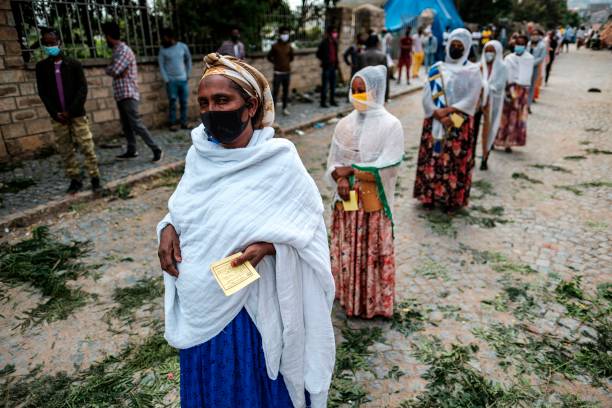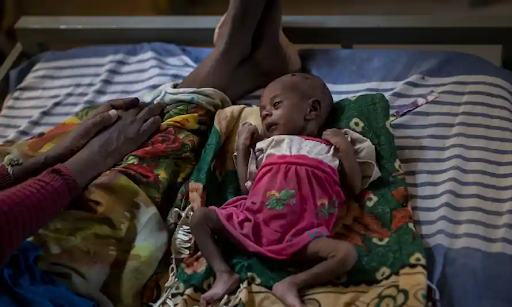Fleeing War – A Personal Experience



The genocidal war in Tigray is being waged on multiple levels. In addition to massacres, widespread sexual and gender-based violence, crop burning, property expropriation, looting, displacement, and forced migration, Tigrayans are suffering the effects of a man-made famine.
This famine has most severely affected children, pregnant women, and nursing mothers; the Tigray External Affairs Office reported in November 2021 that the global acute malnutrition (GAM) rate among children aged 6 months to 59 months was 32. At that time, 28,541 children had been diagnosed with severe acute malnutrition, and malnutrition rates among pregnant and lactating mothers stood at 85 percent.
In his efforts to subjugate the people of Tigray, Ethiopian Prime Minister Abiy Ahmed has deliberately engineered a famine, with tactics including roadblocks to obstruct the delivery of aid into Tigray. According to the United Nations Office for the Coordination of Humanitarian Affairs (UN OCHA) and Tigray’s External Affairs Office, between July 2021 and January 2022, 20,000 trucks should have entered Tigray, however, only 3,000 trucks (15 percent) made it into the region. The famine has been officially acknowledged as man-made by the United Nations (UN) and other official organisations on multiple occasions, and they have also stated that it could be remedied by government action.
In June 2021 the Integrated Food Security Phase Classification (IPC) reported 350,000 Tigrayans as experiencing catastrophic famine conditions. This is the highest number of people placed in this category (IPC 5) in the last 10 years, making Tigray’s hunger crisis the world’s worst in a decade. The same IPC report acknowledged 4 million people – 70 percent of the population – to be at acute risk of famine. The Ethiopian government’s blockade of Tigray and the telecommunications and internet blackout it has imposed on Tigray means this number may be even higher.
In July 2021 the United States estimated the number of Tigrayans experiencing catastrophic famine conditions to be closer to 900,000 people. This number has not been updated since, as humanitarian organizations hardly have any access to the region, especially rural areas where the hunger crisis is most likely the worst. Meanwhile, in a terrifying interview with the BBC that same month, Abiy Ahmed stated “There is no hunger in Tigray.”

What About the ‘Unilateral Ceasefire’?
On June 28, 2021, the Ethiopian government declared a ‘unilateral ceasefire,’ allegedly for humanitarian reasons, including agricultural production and aid distribution. However, this announcement concealed what was in fact a shift in strategy; under the guise of peace-making, the Ethiopian government began a complete siege on the region. Since this ‘unilateral ceasefire,’ conditions in Tigray have only worsened.

Hunger Crisis in Internally Displaced People (IDP) Camps
Due to the blockade and extremely limited humanitarian efforts, those living in IDP camps rely on the residents of their host communities to feed them, communities that are often struggling to feed themselves. Famine-like conditions were limited to rural areas until early July 2021, when they spread to more urban areas, including villages surrounding Mekelle. In September 2021, the Tigray External Affairs Office (NPR) reported that “[A]t least 150 people starved to death in August, 2021, including in camps for [internally] displaced people.” At that time, August 2021, over 20 percent of displaced children were reported to be acutely malnourished as were 79 percent of pregnant and nursing women. In January 2022, 29.1 percent of children under 5 were reported as suffering from acute malnutrition, and 7.1 percent had been diagnosed as having severe acute malnutrition.

Restriction of Access to Information
Ethiopia is a famine- and drought-prone region that has suffered from recurring food shortages. Prior to the war, Ethiopia had already implemented government information systems for tracking, predicting, and classifying food security outcomes. From 2011 to 2017, these systems reported 78 percent accuracy by UN-backed IPC standards (PIA-six case studies). Many reports of malnutrition were made before the complete blockade starting in June 2021, yet this did not stop the government from imposing the blockade and decreasing access to food, water, fuel, medicine, and other necessities.
The actions of the Ethiopian government have made it impossible to obtain accurate and up-to-date information on the crisis; United Nations Emergency Relief Coordinator Martin Griffiths has stated that it is “difficult to know exactly what the situation [is] on the ground in Tigray because of a de-facto aid blockade and lack of fuel.” The reality is likely to be much worse than that given in official data.
Instead of publicly acknowledging the emergency, Abiy Ahmed’s government has denied the famine in Tigray that it has caused.
Restriction of aid
The Ethiopian government has heavily restricted internationational humanitarian organizations’ efforts to alleviate the suffering in Tigray and speak up about the humanitarian blockade by threatening removal access, and the government has made their position explicit. Reports of insecurity have been framed as politically motivated, and humanitarian groups have been accused of supporting Tigrayan fighters. Some aid officials have been expelled for speaking publicly about the government’s role in perpetuating famine. For example in October 2021, seven senior UN officials were told to leave the country, accused by the Ethiopian government of ‘meddling in internal affairs.’
The Secretary-General of the UN, António Guterres, who has rarely spoken out about the dire situation in Tigray, was ‘shocked’ by the decision to expel aid officials, stating that “in Ethiopia, the UN is delivering lifesaving aid – including food, medicine, water, and sanitation supplies – to people in desperate need.” Restricting the ability of the UN and other humanitarian organisations to help the people of Tigray is a core part of Prime Minister Abiy Ahmed’s strategy.
Worsening Famine and Need for Immediate Action
According to the Associated Press, humanitarian workers estimate that more are dying of starvation than recorded; in addition to the intentional restriction of access to information, many deaths are occurring in remote areas or areas controlled by invading forces.
Ethiopian and Eritreans forces have used hunger and starvation as a tool of genocide. Not only have they restricted access and imposed a complete siege on the region, these forces have looted and intentionally destroyed crops and prevented farming during the war, severely disrupting food security in Tigray. The famine is ongoing in 2022 due to limited crop production alongside the continuing fighting and the siege.
In response to the June 2021 BBC interview in which the Prime Minister of Ethiopia stated “There is no hunger in Tigray,” the head of the U.S. Agency for International Development, Samantha Power, stated “This is false.” It is time for the entire global community to explicitly acknowledge this terrifying disparity. Concrete actions must be taken to halt the man-made famine and genocide in Tigray, beginning with ending the siege of Tigray and expediting aid to those who need it the most.
Octavia Sheepshanks – Omna Tigray External Contributor, February 2022